Bath Travel Guide
The Romans established Bath in the year 43 AD and this city, awash with fabulous architecture, history and culture, has been welcoming travellers ever since. Many of Bath's great buildings date back from its renaissance in the 18th century when it again became a fashionable spa town and played host to royalty and the cream of aristocracy, who famously visited the city to 'take the waters'. Today visitors can walk around the old Roman Baths, enjoy the splendour of Bath Abbey or simply take in the breathtaking Georgian architecture of this beautiful city, which somehow managed to escape the ravages of industry and the Luftwaffe.
Jane Austen lived and based several of her books in Bath, and on Gay Street, near her home, visitors can find the Jane Austen Centre, which allows visitors to immerse themselves in her life and times. For an authentic feel of life gone by, period decorations and furniture have been reinstated at No. 1 Royal Crescent, so that the house appears as it did in its days as a fine 18th-century townhouse.
Bath is home to much older attractions than its Elizabethan assets, including the famous ancient Roman baths, situated over natural hot springs. Bath was a prosperous tourist destination as early as its Roman occupation, when the baths were built, and continued its reputation as a therapeutic health resort through the medieval period.
Though architecturally Bath is something of a period piece, it is also a very modern city. Its restaurants and pavement cafes are packed full of local businessmen and artisans, and its cinemas, pubs, and nightclubs keep its residents entertained each evening. Bath's answer to Camden Market is Walcot Street, where a bohemian street market takes place each weekend, its parks and gardens are also popular for relaxing and enjoying pleasant weather.
The International Music Festival marks the beginning of summer and adds to Bath's lively, festive atmosphere. Its Theatre Royal is one of the country's leading provincial theatres, attracting big names and pre-West End show runs.
Things to do in Bath
The city of Bath is a UNESCO World Heritage Site and a hugely popular city to visit for tourists, particularly during the summer months when the streets come alive with visitors, performers and other colourful people.
Culture vultures will love this city as so much of England's history is reflected here, with everything from the Roman Baths and Bath Abbey to the Fashion Museum and Royal Crescent (a residential road of 30 houses laid out in a crescent shape showcasing Georgian architecture), it's like taking a trip back through time. Visitors can head to the Jane Austen Centre to discover all there is to know about Bath's most famous resident; stroll along the Pulteney Bridge and look in its shop windows; visit Sally Lunn's Refreshment House and Museum, the oldest house in town; or take a day trip to visit the iconic ancient ruins at Stonehenge.
Visitors to Bath should make use of the Bath Visitor Card, which is valid for three weeks from the date of validation, and can be picked up from the Bath Tourist Information Centre. The card affords visitors plenty of time to make their way around the city and also offers a wide range of discounts on food, drinks, shopping, attractions and sightseeing tours.
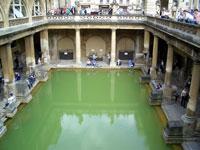
Roman Baths
The Romans were the first to capitalise on the only natural hot springs in Britain, but it is believed that they were a local attraction long before the building of Rome. These ancient baths were once considered the finest in the Roman Empire, but in the middle ages fell into disrepair. It was not until a visit by the ailing Prince George in 1702 that the baths once again became a popular healing destination. Over the course of the city of Bath's redevelopment in the late 18th century, the Roman ruins were rediscovered and restored. Today, visitors can see the seven ancient baths and view the Georgian splendour of the Pump House, where the musty mineral waters can be sampled by the strong of stomach. The magnificent centrepiece is the Great Bath. Lined with lead and filled with hot spa water, it once stood in an enormous barrel-vaulted hall that rose to a height of 131ft (40m). For many Roman visitors, this may have been the largest building they had ever entered in their life.
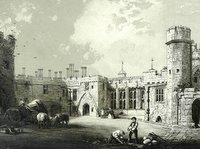
Berkeley Castle
Berkeley is a perfectly preserved 840-year-old castle with a keep, dungeon, and splendid staterooms with original tapestries, furniture, and silver. The castle was most famously the scene of King Edward II's gruesome murder in 1327. It is believed that Edward was deposed by his French consort, Queen Isabella, and her paramour, the Earl of Mortimer. The castle also played an important role in the English Civil War (1642-1649). The oldest part of the castle was built in 1153 by Roger De Berkeley, a Norman knight, and has remained in the family ever since. The surrounding meadows, now the setting for pleasant Elizabethan-style gardens, were once flooded to make a formidable moat.
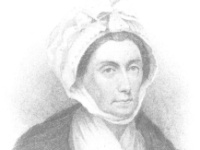
Museum of Bath Architecture
The fascinating story of Georgian Bath is wonderfully presented by the Museum of Bath Architecture. The museum is the natural place to start any sightseeing expedition of Bath. It is housed in the Gothic-styled Countess of Huntingdon's Methodist Chapel, which was built in 1765 and renovated in 1984 by the Bath Preservation Trust. Inside, visitors are treated to a unique exhibition, with installations describing how Bath developed from a small provincial spa to the most fashionable resort in Georgian England. Using models, maps, paintings, reconstructions, live crafting demonstrations and hands-on exhibits, including a touch-screen computer, a visit to the museum is an informative and entertaining experience. Visitors should budget about two hours to take it all in.

Herschel Museum of Astronomy
Distinguished astronomer William Herschel used a telescope he built himself to discover the planet Uranus in 1781, thus securing his place in history as one of the greatest astronomers of all time. His observations, and the telescopes that he built, doubled the known size of the solar system in his time. The telescope through which Uranus was first spied was built in the delightful Georgian townhouse that today houses the Herschel Museum of Astronomy. Visitors to the museum can view Herschel's workshop, as well as the original kitchen and the music room in the house where William lived with his sister, Caroline, at the end of the 18th century.
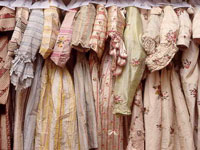
Fashion Museum
Bath's comprehensive Fashion Museum brings alive the story of fashion over the last 400 years, from the late-16th century to the present day. The huge collection is fetchingly displayed on hundreds of dummies, providing a chronological journey through changing styles over the centuries. Visitors can listen to an audio tour or take part in a conducted guided tour of fashion through the ages. Apart from looking at all the fashion, there are opportunities to try on some replica garments for both kids and adults. A highly popular attraction that will appeal to visitors of all ages and from all walks of life, it's best to budget about two hours to do the museum justice.
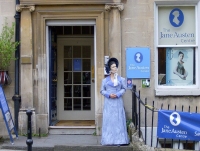
Jane Austen Centre
Bath's best-known resident, Elizabethan novelist Jane Austen, is celebrated in this permanent exhibition, which showcases her life and work. Bath was her home between 1801 and 1806, and her love and knowledge of the city is reflected in her novels Northanger Abbey and Persuasion, which are set in Georgian Bath. The Jane Austen Centre also runs an annual and extremely popular Jane Austen Festival, which holds the Guinness World Record for the largest gathering of people dressed in Regency costumes. This museum is a must for people for whom Bath immediately conjures associations with Austen and her literary world.
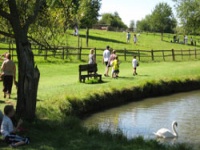
Avon Valley Adventure and Wildlife Park
Located in the beautiful Avon Valley, just four and a half miles (7km) from central Bath, Avon Valley Adventure and Wildlife Park is the perfect day out for families with children. Kids can let loose in the adventure playground, which features a junior assault course, a riverside trail, llamas and wallabies, farm animals like Shetland ponies, a boating pond, and even a miniature railway. Younger kids will love the indoor play area where they can enjoy enormous slides and ball pits. Families should pack a picnic to savour on the riverbanks and enjoy the wide open space and exciting activities.
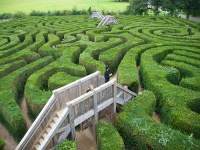
Longleat
Longleat is a bit of a strange tourist destination, catering simultaneously to two very different markets. On one hand, it is regarded as the best example of high Elizabethan architecture in Britain, and one of the most beautiful stately homes that are open to public tours. The magnificence of the house itself is matched by the splendour of its surroundings, a spectacular mix of landscaped parkland, lakes and formal gardens. In 1949, Longleat became the first grand home in England to open its doors to the public, and a few years later opened the first safari park outside of Africa. Visitors can drive through eight enclosures, where a wide range of animals can be seen, including elephants, rhinos, giraffes, monkeys, lions and tigers. In recent years, however, Longleat has also become one of the UK's most popular family tourist attractions, offering a wealth of child-friendly sights and amenities. Visitors should try not to lose their kids in the world's longest maze, made up of more than 16,000 English Yews. Alternatively, they can take the little ones for a ride on the miniature railway or to meet some of the friendly animals at Animal Adventure, before letting them run amok in the Adventure Castle.
Eating Out
Unsurprisingly, Bath is a great destination for foodies: although Michelin-starred or celebrity chef endorsed restaurants are thin on the ground, the restaurant scene is varied and fun with something for everybody and some very good quality establishments for those wanting to splash out.
Visitors should note that there are many good places to eat out just outside of the city, including some quaint old country pubs. Gourmets should consider visiting Bath during the annual Great Bath Feast (usually in October), when the city shows off with farmer's markets, cookery classes, tastings, and chef demonstrations.
There are good restaurants dotted all over the city and it is better for visitors to search for the kind of restaurant they want than to head to a certain restaurant district. Those on a budget will find that there is plenty to choose from. The dominant cuisine is traditionally British, as one would expect from this staunchly English city that relishes tradition and historic charm.
Getting Around
The compact city of Bath can easily be explored on foot or by bicycle, and these slower modes of getting around are the best ways to take in the historic character of the city. Different walking tours, including a ghost walk, are offered, and some are free.
Another great option for visitors wanting to sightsee and get a feel for Bath is to hop on board one of the numerous bus tours, many of which are open-top and offer a hop-on, hop-off service with tickets valid for 24 hours. The city's bus network is also good and connects the city centre and its outskirts. A park-and-ride service is available.
Taxis are unnecessary in the city centre as walking is often much faster, but they are easy to find at the railway station. There are several car hire agencies, but hiring a car is not really necessary unless visitors are planning excursions out of the city. Mobile app based taxi services such as Uber are also commonly used.
Bath Climate and Weather
In common with the rest of southern England, the weather in Bath is temperate but changeable, especially during the summer months, when a cloudy, cool morning can turn into a hot, sunny afternoon. Generally summer days are fine and warm, but spring is the best time to travel to Bath, when the city's parks and gardens are in bloom and the weather is mild. Winters in Bath are cold and very wet. Snow is rare, but days tend to be frosty.
United Kingdom travel info
Electricity
The electrical current in the UK is 240 volts, 50Hz. Flat, three-pin plugs are standard.
Language
English is the official language, though visitors will be astonished by the variety of regional accents.
Money
The currency is the British pound (GBP), which is divided into 100 pence. ATMs are available in almost all towns and Visa, MasterCard and American Express are widely accepted. Foreign currency can be exchanged at bureaux de change and large hotels, though better exchange rates are likely to be found at banks.
Tipping
Tips of 10 to 15 percent are expected in restaurants and upmarket hotels in the UK if a service charge hasn't been included. Hotel service staff receive an optional amount, while taxi drivers are usually given 10 to 15 percent of the fare. Tipping bartenders isn't expected, and tipping for other services is discretionary.
Health
There are no specific health risks associated with travel to the UK and food and water can be considered safe. The British National Health Service is excellent, and a number of countries have reciprocal health agreements with the UK including Australia, New Zealand and EU countries. Visitors from other countries such as Canada, South Africa and the United States are advised to take out comprehensive travel insurance.
Safety
It's generally safe to travel throughout the UK.
Local customs
Handshaking is customary when introduced to someone new. Smoking is banned in all enclosed public spaces, including pubs, restaurants and public transport. Queue barging is frowned upon and there is strict etiquette on escalators: stand on the right, walk on the left. Visitors may find Londoners more rushed and less friendly than locals in other parts of the country, particularly on London transport, where tourists are often the only people who talk.
Doing business
The four countries of the United Kingdom, although culturally and historically different, generally keep to the same business practices. Politeness and punctuality are key to good business relations and initial meetings are often conducted formally and impersonally, becoming more open and social as things progress. Business cards are exchanged at introductions, and dress is formal with dark suits preferred. Business hours are generally 8am to 5pm Monday to Friday with an hour taken at lunch.
The communication style can be difficult to adjust to: the British people respect politeness to a point that often obscures their ability to say exactly what they mean. As a result, travelling business people may need to learn to 'read between the lines' and to take cues from tone of voice and facial expression. Humour is also an integral part of the British system of communication, and is used to diffuse a tense situation and to cultivate relationships. Foreigners should never assume that an attempt at humour undermines a person's ability to do their job, or discredits the importance they attach to a deal or negotiation. Furthermore, they shouldn't be fooled into thinking that the British propensity for irony and sarcasm equates with an informal work environment.
Foreigners should be tactful during meetings, avoid becoming emotional and illustrate their experience with the subject at hand. Performance and initiative are looked upon favourably, whereas academic pretension is given far less credence. Meetings are often used as platforms for debate, rather than moments of confirmation, so there should be no surprise if not much progress is made. Foreigners should be sure to respect and appeal to all parties involved, as the British have recently begun to take a far flatter approach to management and the responsibility of decision-making. And if things go well, it's worth purchasing a pint or two for clients or colleagues; though gifts are borderline inappropriate, a round of drinks will rarely be refused.
Duty free
Travellers can bring the following goods into the UK tax or duty free: 200 cigarettes, 100 cigarillos, 50 cigars or 250g of tobacco, 18 litres of still table wine, 42 litres of beer, 4 litres of spirits or strong liqueurs or 9 litres of fortified wine, sparkling wine or other alcoholic beverages of less than 22 per cent volume.
Communications
The international country dialling code for the UK is +44. Mobile phone coverage is extensive and free WiFi is widely available in pubs and coffee shops. Travellers can purchase local prepaid SIM cards for unlocked phones or use eSIMs if their cellular providers support it on their networks.
Passport & Visa
If a visa is not required, travellers should hold a return or onward ticket, and proof of funds for the duration of stay. Passports must be valid for the period of intended stay in the UK. It's highly recommended that travellers' passports have at least six months' validity remaining after the intended date of departure from their travel destination. Immigration officials often apply different rules to those stated by travel agents and official sources. For visitors who are visa exempt up to a maximum stay of six months, the period of stay will be determined by the Immigration Officer on arrival.
Entry requirements
US travellers must hold a passport that is valid for the duration of their stay; a visa is not required for stays of up to six months.
Canadian passports must be valid for at least the expected duration of the stay. No visa is required for stays of six months or less.
Australian passports must be valid for at least six months after the departure date. No visa is required for stays of six months or less.
South Africans require a valid passport and a visa for entry or transit through the UK. South African temporary passports are not recognised.
Under the Common Travel Area agreement, citizens from the UK and Ireland are not required to pass through passport control. They can travel between both countries without a valid passport if they can prove they are a valid UK or Irish national.
New Zealand nationals must hold a valid passport, but no visa is required for stays of up to six months.
Useful contacts
United Kingdom Tourism Website: www.visitbritain.com
999 (General)Embassies / consulates in other countries
British Embassy, Washington DC, United States: +1 202 588 6500.
British High Commission, Ottawa, Canada: +1 613 237 1530.
British High Commission, Canberra, Australia: +61 2 6270 6666.
British High Commission, Pretoria, South Africa: +27 12 421 7500.
British Embassy, Dublin, Ireland: +353 1 205 3700.
British High Commission, Wellington, New Zealand: +64 4 924 2888.
Embassies / consulates in United Kingdom
United States Embassy, London: +44 20 7499 9000.
Canadian High Commission, London: +44 20 7004 6000.
Australian High Commission, London: +44 20 7379 4334.
South African High Commission, London: +44 20 7451 7299.
Irish Embassy, London: +44 20 7235 2171.
New Zealand High Commission, London: +44 20 7930 8422.



